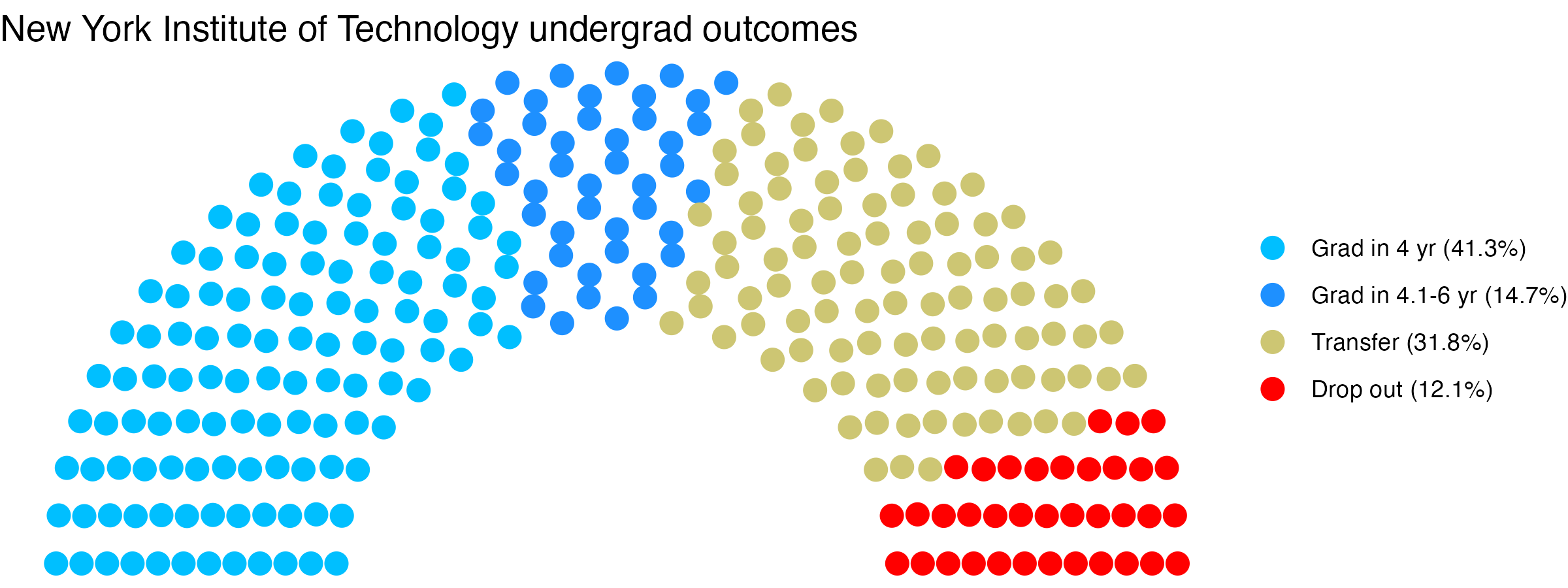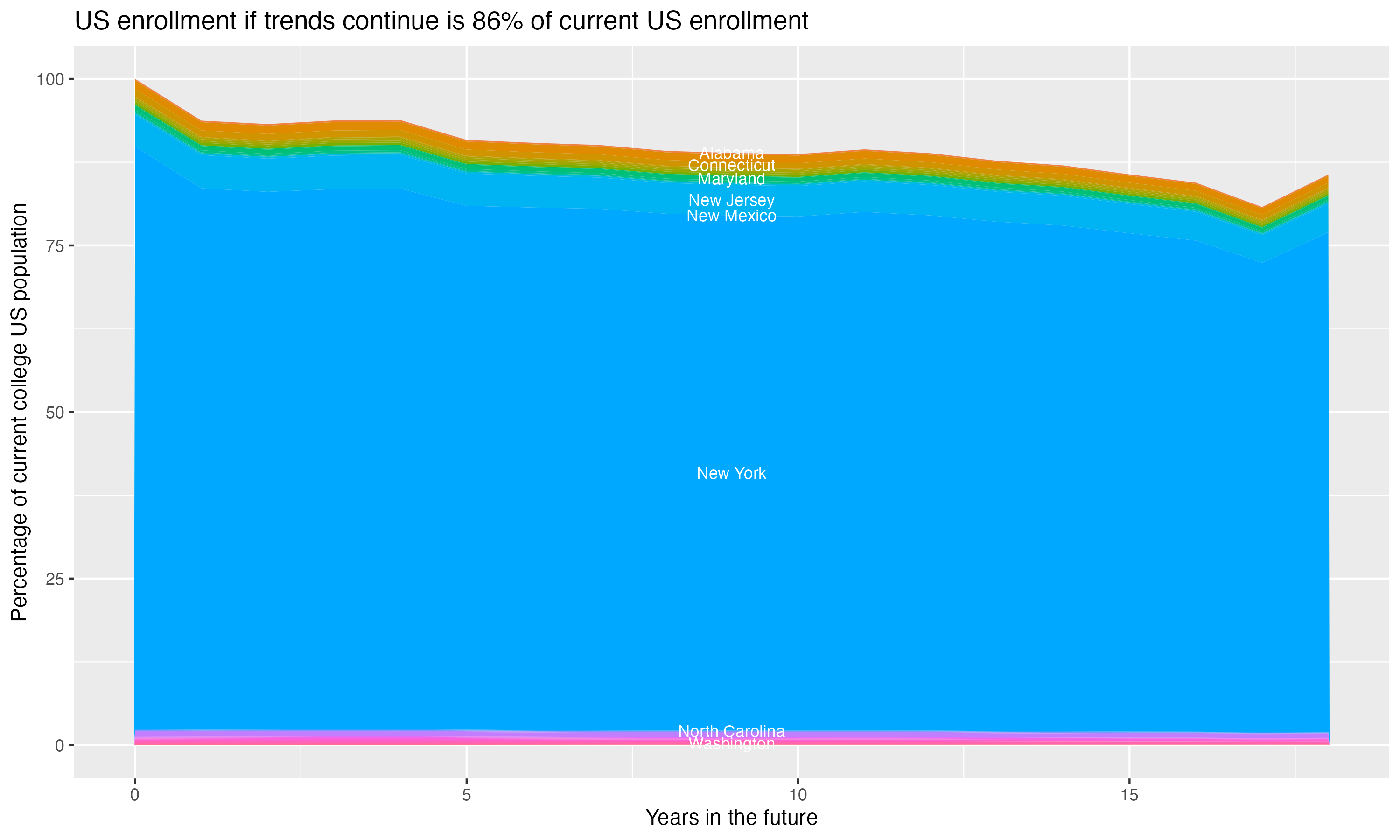New York Institute of Technology
New York Institute of Technology is located in Old Westbury, New York. It is a private not-for-profit, 4-year or above institution.
From Wikipedia: The New York Institute of Technology (NYIT or New York Tech) is a private research university with two main campuses in New York, one in Old Westbury, on Long Island, and one on the Upper West Side in Manhattan. The university was founded in 1955. In addition to its main campuses, it has a cybersecurity research lab, a biosciences and bioengineering lab, Nassau County’s first Class 10,000 clean room for nanoengineering, and the Entrepreneurship and Technology Innovation Center, which has close links to NASA, in Old Westbury, as well as campuses in Arkansas, China, and Canada. The United States Department of Defense and the United States Department of Homeland Security designated NYIT as a National Center of Academic Excellence in Cyber Defense Education. NYIT has over 100 undergraduate and graduate degree programs. It awards bachelor’s, master’s and doctoral degrees for the completion of these programs. It has five schools and two colleges, all with an emphasis on technology and applied scientific research. NYIT’s 2025 Carnegie Classification has been designated as a Mixed Undergraduate/Graduate-Doctorate Medium. The New York Institute of Technology Computer Graphics Lab has played an important role in the history of computer graphics and animation, as founders of Pixar and Lucasfilm, including Turing Award winners Edwin Catmull and Patrick Hanrahan, began their research there. NYIT is the birthplace of entirely 3D CGI films. New York Tech enrolled 7,711 full-time students across its campuses worldwide in 2023. NYIT’s intercollegiate competitive sports teams, include its four-time NCAA Division II national champion lacrosse team. All of NYIT’s teams compete in Division II. The NYIT Bears are part of the East Coast Conference. New York Tech’s alumni and faculty include academic scholars, literary and media figures, National Academies members, inventors, government officials, international royalty, professional athletes, Olympians, billionaires, founders and chief executives of Fortune 500 companies, and recipients of Turing Awards, Emmy Awards, and Academy Awards.
Overview of institution
This, and the rest of the page, use info from the most recent year available, generally 2024.
Institution kind: Master’s Colleges & Universities: Larger Programs
Undergrad program: Professions plus arts & sciences, some graduate coexistence
Graduate program: Postbaccalaureate: Other-dominant, with Arts & Sciences
Enrollment profile: Majority undergraduate (see more details below)
Average net price for undergrads on financial aid: $23,074 (1.3 times the equivalent cost of Harvard).
Actual price for your family: Go here to see what your family may be asked to pay. It can be MUCH lower than the average price but also higher for some.
Size and setting: Four-year, medium, primarily nonresidential
In state percentage: 79% of first year students come from New York
In US percentage: 91% of first year students come from the US
Graduation rate (within 6 years) for students seeking a Bachelors: 56% (this is what is usually reported as “graduation rate”)
Graduation rate (within 4 years) for students seeking a Bachelors: 41.3%
Percent of students seeking a Bachelors who transfer out of this institution: 31.8%
Student to tenure-stream faculty ratio: 17.1 (undergrads to tenure-stream faculty) [Tenure explained]
Student to faculty ratio: 10.0 (undergrads to all faculty)
Degrees offered: Certificate of less than 1 year, Certificate of at least 12 weeks but less than 1 year, Associate’s degree, Bachelor’s degree, Postbaccalaureate certificate, Master’s degree, Post master’s certificate, Doctor’s degree: research scholarship, Doctor’s degree: professional practice
Schedule: Semester
Institution provides on campus housing: Yes
Dorm capacity: There are enough dorm beds for 244 students
Freshmen required to live on campus: No
Advanced placement (AP) credits used: Yes
Disabilities: 3 percent or less of undergrads are registered as having disabilities.
Undergrad outcomes
This plot shows the outcomes for first time, full time undergraduates seeking Bachelor’s degrees (if the data are available).

Map
Comparisons
The sections below show this institution compared with others. The ones listed are ones it has identified as peers, who consider themselves peers, and/or who the federal government considers peers. If a comparison school has the same value as the focal school, its cell is grayed out. In fields where there is a common view that higher (or lower) values are better, the best values are in blue, the worst values are in red. If there isn’t a sense of a particular value being better, values are shown in varying shades of green. Arrows show where there is a signficant trend over time for a school. You can swipe across the table to see more of it; the focal school column is always visible.
- New York Institute of Technology lists these schools as ones to compare itself within federal IPEDS data, and they do the same back: St. John’s University-New York, Adelphi University
- New York Institute of Technology compares itself to these institutions, but not vice versa: Stevens Institute of Technology, CUNY Hunter College, Rochester Institute of Technology, New Jersey Institute of Technology, Drexel University, University at Albany, Farmingdale State College, Hofstra University, Pace University, Manhattan University, Long Island University, SUNY Old Westbury
- These institutions compare themselves to New York Institute of Technology, but not vice versa: Touro University, DePaul University, Rose-Hulman Institute of Technology, Molloy University, Florida Institute of Technology, Monroe University, University of Wisconsin-Stout, Widener University, University of Hartford, University of New Haven, Berkeley College-Woodland Park, Berkeley College-New York, University of New England, Mercy University, SUNY Polytechnic Institute, New York School of Interior Design, Edward Via College of Osteopathic Medicine, Midwestern University-Glendale, Midwestern University-Downers Grove, Hawaii Pacific University
Enrollment

General
Teaching
Tenure track faculty are those who are eligible for tenure. This includes both pre-tenure and tenured faculty. Once faculty get tenure, they are (generally) protected from being fired for intellectual reasons, helping to ensure their freedom in teaching and research. They can still lose their positions for misconduct, financial problems, not fulfilling their duties, or other reasons.
Non-tenure track faculty are not eligible for tenure. Some are hired one semester at a time, some have multi-year contracts. They typically have a higher teaching load than tenure track faculty, leaving less time for research or other creative endeavors. They are also easier to fire than tenured faculty. Sometimes they are external experts (a noted musician, a former senator) who are hired to teach some classes without the expected permanence of a tenure-track position.
Note that this chart uses US federal demographic data: it only has two genders and a specified set of ethnicities and races.
Having a low student to faculty ratio is considered a good thing by many, as it can mean more individual attention.
Geography
This has information on the location of the institution. See the about page for more information on what the metrics are and how they are calculated.
Financial Aid
Graduation
Note these are bachelors graduation rates in six years, not four (this is standard). Sample sizes can be small for some demographic groups with few individuals in a school, leading to large year-to-year fluctuations and often extreme values for those groups (if there are two individuals in the class with a given identity, the possible graduation rates are 0%, 50%, or 100% depending on whether zero, one, or both students graduate within six years).
Library
Libraries are changing rapidly. Note that how institutions count digital collections may vary.
Diversity
The US Census Bureau has a diversity index that goes from 0 to 1. In their words, “A 0-value indicates that everyone in the population has the same racial and ethnic characteristics. A value close to 1 indicates that everyone in the population has different racial and ethnic characteristics.” This uses their formula, but with the resolution available for the federal IPEDS data (which does not separate for a given demographic group whether members identify as Hispanic or not). This metric is about heterogeneity within the population, not the proportion of the population that comes from historically excluded groups.
Following the practice of the census, the index is multiplied by 100 to give the percentage probability a random pair of individuals will have a different background. Most institutions argue that diversity is a benefit, so by default a higher number is listed as better, but there may be cases where this measure does not reflect the mission of a college (for example, 70% of the students at a tribal college or university may be American Indian: that could be low-scoring by this metric but should not be read as “bad” given the institution’s mission).
These numbers are based on the most recent year available, generally 2024, which predates effects of the US Supreme Court’s striking down of affirmative action. This has often changed, sometimes dramatically, the incoming student demographics at some institutions.
Overall diversity
Freshman profile
Demographic data for first time degree-seeking students. Note that this uses US federal demographic data: it only has two genders and a specified set of ethnicities and races.
Freshman geography
Test scores
SAT scores
ACT scores
Majors
This presents information on the number of majors and the median earnings one and five years after graduation for people who got a degree from this institution in that field. The earnings are for those who are working and not enrolled in further education. The earnings data (from the federal college scorecard) also has information on earnings for those categorized as ‘MALE’ and ‘NOMALE’ – for readability, these are recategorized here as “Men” and “Women”, respectively, which adopts the gender binary used in other federal data. “W/M earnings ratio” is the median earnings of women divided by men, as a percentage.
Bachelors
Masters
Doctorate
Certificate
Associates
Demographic cliff
There is a concern that giving changing US demographics, the number of students in the age groups who most commonly attend four year colleges will drop off, decreasing overall enrollment. This is often referred to as the “demographic cliff”, and it can be a concern for colleges concerned about the risk of falling enrollment. For this section, the analysis uses US census data on the number of people in each state by age, and the proportion of students that come from each state for this particular college, to crudely model what will happen if everything remains constant except the demographic change in the population of 18 year olds in each year – it does not account for things like the college increasing its admission rate, attracting more students from states without the same demographic changes or from other countries, or changes in the proportion of students who go to college.
